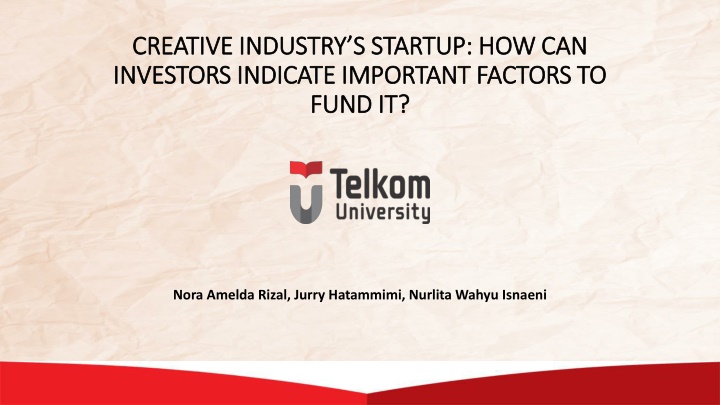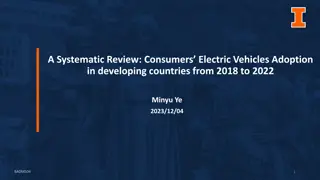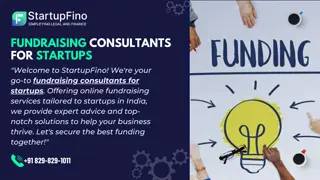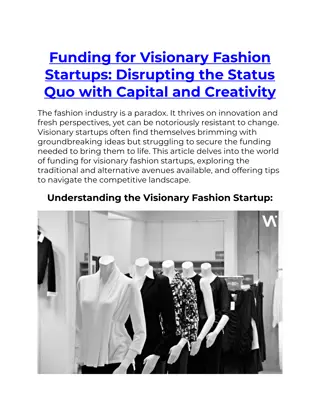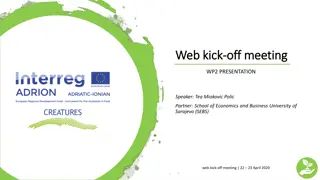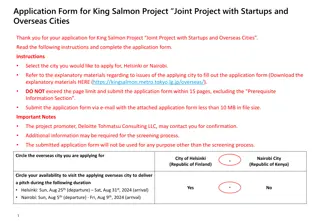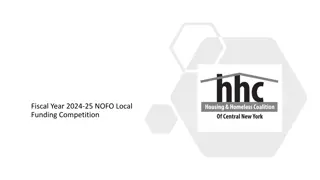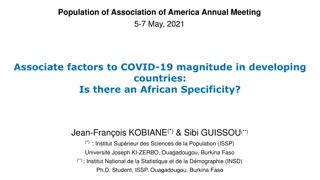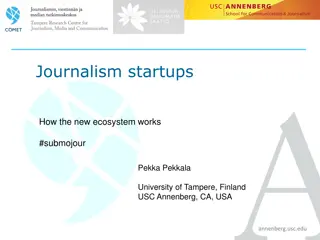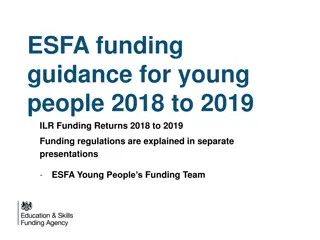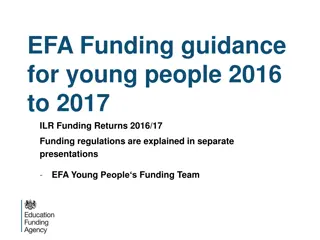Factors Influencing Funding for Creative Industry Startups in Developing Countries
the crucial factors influencing funding for creative industry startups based on a literature review. Learn how investors can indicate important factors to fund creative industry startups efficiently.
Download Presentation

Please find below an Image/Link to download the presentation.
The content on the website is provided AS IS for your information and personal use only. It may not be sold, licensed, or shared on other websites without obtaining consent from the author.If you encounter any issues during the download, it is possible that the publisher has removed the file from their server.
You are allowed to download the files provided on this website for personal or commercial use, subject to the condition that they are used lawfully. All files are the property of their respective owners.
The content on the website is provided AS IS for your information and personal use only. It may not be sold, licensed, or shared on other websites without obtaining consent from the author.
E N D
Presentation Transcript
CREATIVE INDUSTRYS STARTUP: HOW CAN CREATIVE INDUSTRY S STARTUP: HOW CAN INVESTORS INDICATE IMPORTANT FACTORS TO INVESTORS INDICATE IMPORTANT FACTORS TO FUND IT? FUND IT? Nora Amelda Rizal, Jurry Hatammimi, Nurlita Wahyu Isnaeni
PHENOMENA 1. Creative economy contribution to the national GDP continuous to grow In 2015 to 2016 increased by 8.21% 1000 922.59 852.56 900 784.87 800 708.27 638.39 700 581.54 The creative economy is an economic activity based on creativity, skills, and individual talents to build creativity and creative power of individuals who have economic value and influence to the welfare of society 600 525.26 500 400 300 200 100 0 In trillion rupiahs 2010 2011 2012 2013 2014 2015 2016
PHENOMENA 2. The creative economy is driven by the industrial sector called the creative industry The creative industries are the industries that emerge from the utilization of creativity, skills and individual talents to create welfare opportunities through the creation and utilization of the creativity of these individuals and employment
PHENOMENA 3. The difficulties faced by the creative industries actors are to get funding Access to creative economy capital in 2015 Business Actor 74.90% Bank Loan 24.44% Venture Capital 0.66% 0.00% 10.00% 20.00% 30.00% 40.00% 50.00% 60.00% 70.00% 80.00%
Literature Review 1. Cunningham et al. (2008: 81) said that the funding model for the creative industry would have different parameters in each country depending on where the funding was given and the requirements of the banks owned by each country. He shared the factors that influence the funding of creative industries in developing countries into 2 variables including requirements for loans, credit and funding and; organizational and institutional. 2. Stankeviciene and Zinyte (2011) propose a new business evaluation model by weighting several key criteria including, investment period, financing model, andportfolio of company s profile 3. Choi (2013) states that endorsement and time to IPO are important factors in making investment decisions 4. Dumitrescu (2014) states that in order to obtain thematic funding opportunities, small and medium enterprises need to present sustainability, transnational, and value added. 5. Kuschel et al (2016) stated that the business stage and network are the main category that influences funding for an technology- based startups 6. Shah and Shah (2017) state that market feasible and innovation concepts are the main attraction for success in obtaining funding 7. Botric and Bozic (2017), the valuation aspect used in his research on access to funding is positive expectation 8. Cooke (2017) states the importance of having the Intellectual Property Right for what is found or created 9. Hatammimi and Rizal (2018) discuss the indicators that influence funding for creative industry startups in developing countries through a literature review grouped into the variables by Cunningham et al (2008) by adding indicators obtained from studies 2 to 8
Significance Cunningham et al. (2008: 81), and Hatammimi and Rizal (2018): funding in creative industries startups in emerging market Stankeviciene and Zinyte (2011), Choi (2013), Dumitrescu (2014), Kuschel et al (2016), Shah and Shah (2017), Botric and Bozic (2017): important factor and indicators that influence funding in startups
Contribution on This Paper To provide knowledge and insight about the indicators used by investors before investing their funds in creative industry startups in Indonesia Research Question Does variables and indicators found are indeed suitable to be applied in Indonesia Research Objective To confirms indicators that affect funding the creative industry startups in Indonesia
Research Method This study used explorative qualitative method, a deductive approach is carried out using existing theories to find out whether the indicators contained in existing parameters can be implemented in Indonesia
Research Method Triangulation was used to achieve validity and reliability of the data, the steps can be seen as : 1. Interview Using non probability sampling method called convenience sampling, there are three selected respondents. The sample are investors under Indonesia s Creative Economy Agency (Bekraf) under criteria: Investors under Indonesia s Creative Economy Agency (Bekraf) that coming to the Go- Startup Indonesia event on October 26, 2018 in Bandung Investors must have the experience investing in creative industrial startups especially the subsector of application and game developers Agreed to be interviewed within 2 weeks since first contacted
WHY BEKRAF? The Creative Economy Agency (Bekraf) is an institution responsible for the development of the creative economy in Indonesia Bekraf manages 16 sub-sectors of the creative economy Bekraf has several investors who are collaborating in facilitating access to funding for creative economic actors
Why Aplication and Game Developer Sub-sectors? In 2020 digital startups are have the potential to increase by 6.5 times larger from 2017, which is 2000 digital startups. Supported by predictions that 40% of the total population in Indonesia has used the internet This subsectors hold intangible assets which means its difficult to calculate the credit risks that need to be known to get funding from banks or other financial institution Source: BEKRAF
Triangulation The main point is to gain good understanding from different prespective of an investigated phenomenon. That should not necessarily mean cross checking data from at least two sourches or methods and confirming it is correct or not. It s more to increase the level of knowledge about something and to strengthen the researcher s standpoint from various aspect Alan Bryman (Social Research Method, Oxford) Source: www.researchgate.net
Research Method 2. The results of interviews in the form of audio will be converted into text or commonly referred to as verbatim transcription 3. Coding data The data will be reduced and put into category according to the research objectives. 4. Intepretation Data that has been reduced and presented systematically will be concluded and verified. 5. Conclusion The researcher gives his views and perspectives on the research findings Verbatim Transcription
Research Variable and Indicators Variable Indicator Business Stage Loan/Credit/Funding Investment Period Financing Model
Research Variable and Indicators Variable Positive Expectation Indicator Network Market Feasible Idea Concept Innovation Endorsement Organizational & Instiutional Time to IPO Sustainability Transnational Value Added Intellectual Property Right Portfolio Company's Profile
Result and Analysis Variable Indicator Research Result Respondent 2 agreed that the business stage is an influencing indicator when valuing a startup before making an investment, this is suitable with the research of Kuschel et al (2017) Business stage Loan, Credit, and Funding Respondent 2 and Respondent 3 agreed that investment period is an influencing indicator when valuing a startup before making an investment, this is suitable with the research of Stankevi ien and inyt (2011) Investment period Respondent 3 agreed that financing model is an influencing indicator when valuing a startup before making an investment, this is suitable with the research of Stankevi ien and inyt (2011) Financing model
Result and Analysis Variable Indicator Research Result Respondent 2 agreed that positive expeectation is an influencing indicator when valuing a startup before making an investment, this is suitable with the research of Botric and Bozic (2017) Positive Expectation Respondent 2 agreed that network is an influencing indicator when valuing a startup before making an investment, this is suitable with the research of Kuschel et al (2017) Network Organizational & Institutional Respondent 2 and Respondent 3 agreed that market feasible idea is an influencing indicator when valuing a startup before making an investment, this is suitable with the research of Shah and Shah (2017) Market Feasible Idea Respondent 2 agreed that concept innovationis an influencing indicator when valuing a startup before making an investment, this is suitable with the research of Shah and Shah (2017) Concept Innovation Respondent 2 and Respondent 3 agreed that endorsement is an influencing indicator when valuing a startup before making an investment, this is suitable with the research of Choi (2014) Endorsement Respondent 1 and Respondent 3 did not agree that time to IPO is an influencing indicator when valuing a startup before making an investment, this is suitable with the research of Choi (2014) Time to IPO
Result and Analysis Variable Indicator Research Result Sustainability Respondent 1 and Respondent 3 agreed that sustainability is an influencing indicator when valuing a startup before making an investment, this is suitable with the research of Dumitrescu (2014) Respondent 2 and Respondent 3 agreed that transnational is an influencing indicator when valuing a startup before making an investment, this is suitable with the research of Dumitrescu (2014) Transnational Organizational & Institutional Respondent 1 and Respondent 3 agreed that value added is an influencing indicator when valuing a startup before making an investment, this is suitable with the research of Dumitrescu (2014) Value Added All three Respondent agreed that IPR is an influencing indicator when valuing a startup before making an investment, this is suitable with the research of Cooke (2017) Intellectual Property Right Respondent 1 and Respondent 1 agreed that portfolio company s profile is an influencing indicator when valuing a startup before making an investment, this is suitable with the research of Stankevi ien and inyt (2011) Portfolio Company s Profile
Indicators in parameters of Loan, Credit, and Funding: Indicators in parameters Organizational & Institutional: Positive Expectation Network Market Feasible Idea Concept Innovation Endorsement Time to IPO Sustainbility Transnational Value Added IPR Portfolio Company Profile Business stage Investment period Financing Model
Conclusions There are two (2) variables indicated in this research, first of all, parameters of loans, credit and funding and second of all; organizational, and institutional parameters. Based on the result, data processing and discussion in this study: 1. In parameters of loans, credit and funding all three (3) indicators were approved by the respondents which is business stage, investment period, and financing model. 2. On organizational, and institutional parameters, only ten (10) of the eleven (11) indicators were approved by respondents. These indicators are positive expectation, network, market feasible ideas, innovation concepts, endorsement, sustainability, transnational, value added, intellectual property right and portfolio company s profile. Time to IPO is considered not to be part of the consideration in assessing new startups or businesses when investing.
